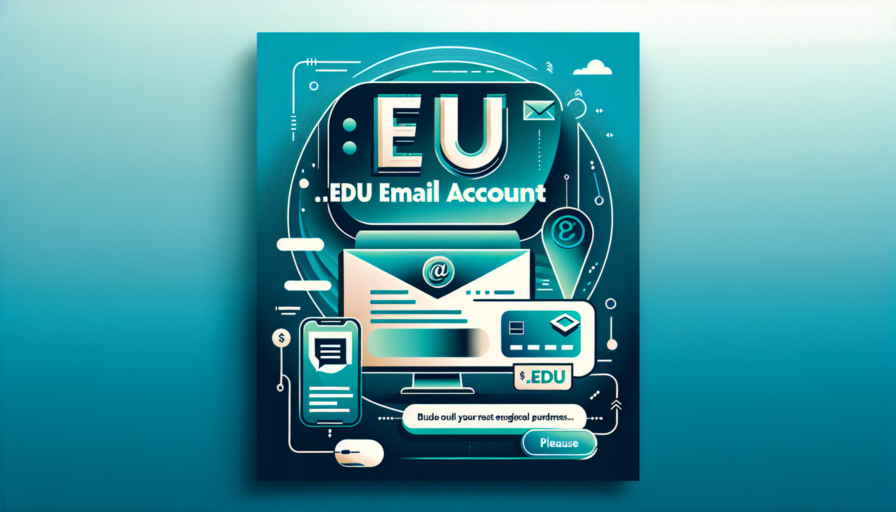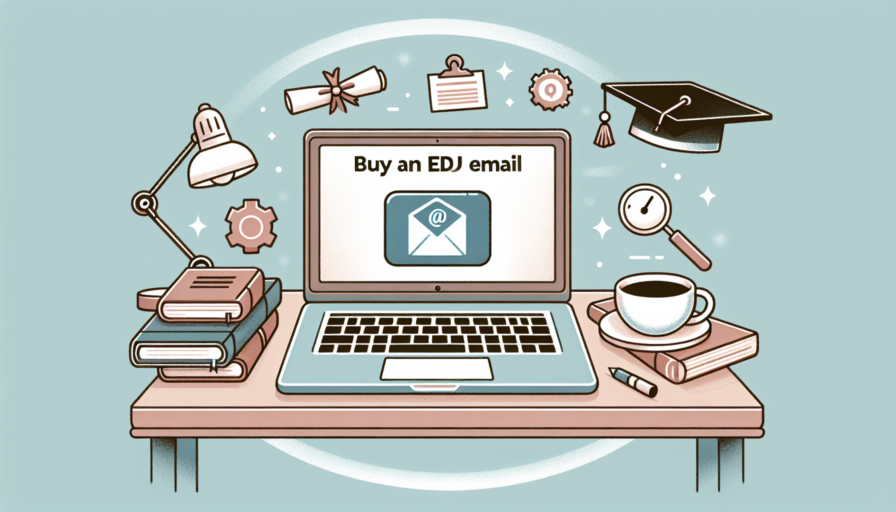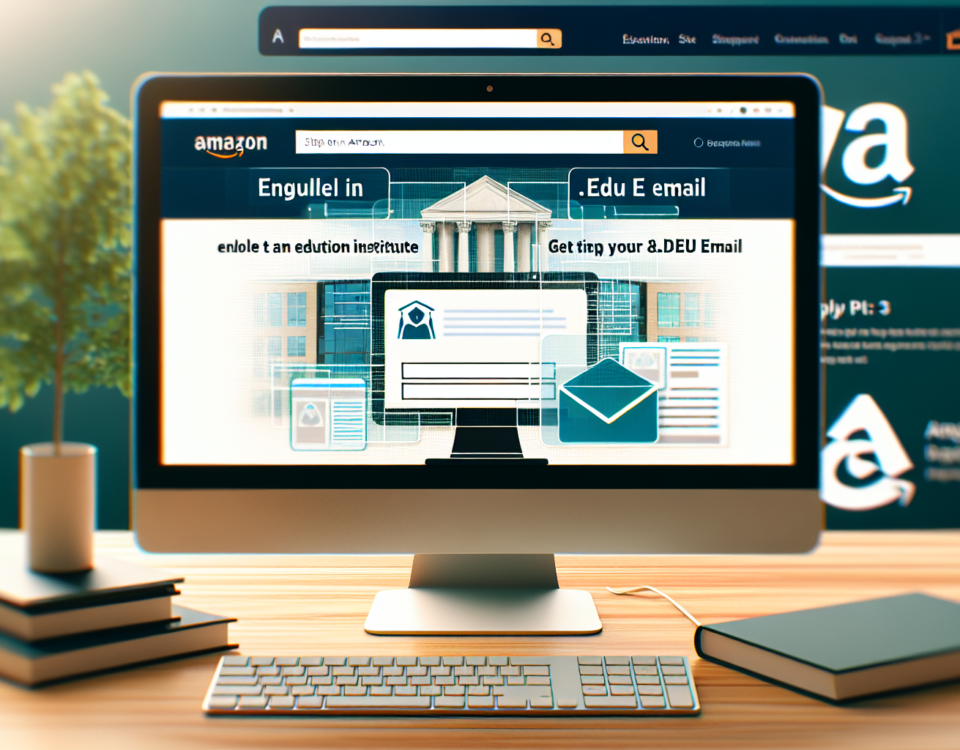Ultimate Guide to Creating an .edu Email on Gmail: Tips & Tricks for Students
February 15, 2024Buy Edu Email Accounts: Exclusive Offers on Legitimate Educational Emails
February 15, 2024Why You Should Consider Getting an EDU Email Account
Having an EDU email account may seem specific to students and educators, but the benefits it offers can extend beyond educational purposes. For starters, EDU email addresses often come with perks and discounts that are exclusive to the academic community. Companies such as Apple, Microsoft, and Adobe offer significant price reductions on software and services for users with a valid EDU address. This can include anything from free or reduced-cost access to productivity apps, creative suites, and learning platforms that are instrumental in personal development and skill-building.
In addition to financial advantages, an EDU email account is frequently associated with a level of credibility and trustworthiness. When you communicate with an EDU email, recipients may be more likely to perceive your messages as legitimate and tied to an academic institution. This enhanced trust factor can be critical when reaching out for academic opportunities, networking, or even in professional scenarios where your scholarly background is advantageous. It fosters a professional image that can be beneficial in various endeavors, whether they’re academically aligned or not.
Another key consideration is the access to a wealth of academic resources that comes with an EDU email account. Many online libraries, publications, and databases offer free or improved access to account holders with an EDU email. From research papers to specialized journals, having the right email extension can unlock a treasure trove of information that can assist in research, continuous education, or personal interests related to academia. Moreover, students and educators can connect and collaborate more seamlessly within educational networks and platforms, enhancing the academic experience.
Beyond educational resources, an EDU email account also comes with enhanced storage solutions and IT support generally afforded to educational institutions. Users may benefit from increased email storage capacity, robust cloud storage options, and dedicated IT support that can be invaluable for keeping data secure and accessible. This type of institutional backing can provide peace of mind for users who rely heavily on their email for work and study-related matters, ensuring that their digital correspondence and materials are well-maintained.
Eligibility Requirements for an EDU Email Account
Securing an EDU email account comes with a plethora of benefits, ranging from software discounts to access to exclusive educational resources. However, not everyone qualifies for these coveted accounts. The primary eligibility criterion for an EDU email account is being a part of an educational institution such as a university, college, or school. This means that students, faculty members, teachers, and sometimes even alumni can apply for an EDU email account. It’s pertinent for applicants to prove their affiliation with their educational institution through documentation such as an admission letter, employee ID, or valid certification indicating their current association with the institution.
To further drill down on eligibility specifics, students must typically be enrolled in an accredited higher education institution. This entails either being a part-time or full-time student pursuing a degree or diploma. The definitions of accreditation may vary based on the country and its educational accreditation bodies. Nevertheless, these institutions are usually recognized by the Department of Education or a comparable governmental authority. For school staff or faculty members, requirements for obtaining an EDU email often encompass being under current employment by the educational institution, with corroborating documents such as a recent pay stub or employment verification letter.
In situations involving alumni, some educational institutions extend the privilege of maintaining an EDU email account post-graduation. However, the continuity of such an account is not universal and would depend on the institution’s policies. Some schools may offer an EDU email for a grace period following graduation, after which the account may be deactivated or its services severely limited. Note that prospective applicants need to check with their respective institution’s IT or administrative department for precise details on alumni eligibility.
When considering applicants below university level, the regulations tighten slightly. Typically, for K-12 students to be issued an EDU email account, parental consent is required alongside the student’s valid school identification. It should be noted that the issuance of EDU email accounts at this level is less common and might be restricted for use under strict educational purposes and monitoring. These accounts serve to introduce younger students to the digital realm of education, hence the need for appropriate safeguards and responsible usage guidelines.
Step-by-Step Guide to Apply for an EDU Email Account
Applying for an EDU email account can open up a variety of benefits, from software discounts to access to exclusive educational resources. To get started on acquiring your own .edu email address, follow this detailed guide to navigate the application process with ease.
Check Eligibility Requirements
The first essential step is to verify your eligibility. EDU email accounts are typically reserved for students, faculty, and staff at educational institutions. Be prepared to provide a proof of your enrollment or employment at a qualifying school, college, or university. Always check the specific criteria outlined by the institution, as these may vary.
Create an Account with Your Institution
Once eligibility is confirmed, proceed to your educational institution’s website to create an account. Look for the section dedicated to email services or IT support, where you can find detailed instructions or direct links to sign-up pages. Here, you’ll be prompted to enter personal information such as your full name, date of birth, and potentially your student or employee ID number. Ensure that all provided information is accurate to prevent any delays in the verification process.
Verification and Activation
After submitting your information, you’ll likely face a verification stage. This can be an automated email confirmation or a manual review by the institution’s IT department. Once your association with the educational institution is validated, you will receive instructions for activating your account.
Keep in mind that while some institutions grant immediate access to EDU email accounts, others may have a waiting period. It’s also crucial to regularly check your provided alternate email for any updates or follow-up requests from the institution. Patience is key, as the verification and setup process can take several days, especially during peak enrollment periods.
Maintaining Your .EDU Email Account Beyond Graduation
It’s a common misconception that your university-provided .EDU email account comes with an expiration date closely tied to graduation. However, many educational institutions recognize the ongoing value their alumni bring and offer extended or lifetime access to these email services. Retaining your .EDU email address not only serves as a hallmark of your academic achievements but also opens doors to a myriad of benefits and discounts that are exclusive to educational addresses.
Alumni Networks and Opportunities: Maintaining your .EDU email account can be crucial for staying connected with alumni networks. Such networks often play a significant role in post-graduation opportunities, including career advancement, mentoring programs, and continuing education. Through this account, you can receive updates about alumni activities, networking events, and potentially influential contacts within your field of study or industry. Also, as an alumnus, you might have access to university resources and facilities, and your .EDU email can be the key to unlocking these perks.
Discounts and Software Access: Your .EDU email address is like a golden ticket to a plethora of discounts on software, subscription services, and technology products. Companies like Adobe, Microsoft, and Apple offer substantial educational discounts that extend beyond your time as an active student. Retaining your .EDU email could mean continual access to these savings, providing both professional tools for young graduates entering the workforce and personal benefits for those conscious of their budget.
It’s important to familiarize yourself with your institution’s policy regarding .EDU email accounts post-graduation. Some schools may require you to actively keep the account in use, while others may transition you to a dedicated alumni email domain. Regularly using your .EDU email for correspondence, subscriptions, and account registrations can signal to your alma mater that the account remains active and valuable. If you’re unsure about your university’s specific policies, reaching out to the alumni relations department can provide clarity and help you ensure continuous access to this vital resource.
Common Problems and Solutions When Creating an EDU Email Account
Creating an EDU email account offers numerous benefits, including access to educational resources and potential discounts on software and services. However, individuals sometimes encounter challenges during the setup process. Addressing these common issues promptly can lead to a smoother account creation experience.
One frequent difficulty users face is eligibility verification. Educational institutions often require proof of enrollment or employment before granting an EDU email account. If you’re having trouble with this step, it’s important to check the documentation you’re submitting is up-to-date and adheres to the institution’s requirements. Many times, a simple update to your records or submitting additional evidence of your educational status can resolve this issue.
Another obstacle is the actual account creation process, which can be unusually complicated. It’s not uncommon for users to get lost in a labyrinth of links and forms. To avoid this, closely follow each step provided by your institution’s guidance, and don’t hesitate to seek help from their technical support team. Additionally, ensure that you are using a compatible web browser and that you have all necessary information, such as a student ID or access code, on hand before beginning.
Miscommunication or issues with receiving a confirmation email prove to be a hindrance as well. This is where checking junk or spam folders becomes crucial. If the confirmation email is not in your main inbox, it’s possible it was mistakenly filtered out. Also, verify that the email address you provided during the sign-up process was correct and capable of receiving messages. If a substantial amount of time has passed and you haven’t received your confirmation, reaching out to your institution’s IT support team may be necessary to ensure that your application wasn’t lost in the shuffle.
Persistent login problems post-account creation can also mar the experience. These can often be resolved by resetting your password using the provided recovery options, ensuring that caps lock is turned off, and confirming that no key errors were made while entering your credentials. In the event these steps don’t resolve the issue, contacting support for further assistance would be the next best course of action. Remember to check for any maintenance alerts or service outages that might be temporarily affecting account access before concluding there is a severe problem.
Wrap-Up: Ensuring Success in Obtaining Your EDU Email
When endeavoring to secure your .edu email address, several steps are crucial to ensure a smooth process. First and foremost, it’s important to ensure that you’re eligible for an .edu email address by being affiliated with an accredited educational institution. This could mean you are a student, faculty member, or staff at a college or university. Typically, these institutions have specific eligibility criteria that you must meet, so checking with your school’s IT or admissions office is a wise first step.
Another key factor is to submit accurate and up-to-date information during the sign-up process. Educational institutions usually require proof of identity and your relationship with the institution. This can come in the form of student or employee identification numbers, enrollment or employment documents, and sometimes additional verification through a school portal or designated sign-up pages.
Maintaining your .edu email account also comes with responsibilities. Make sure to log in regularly, update your password as needed, and comply with any institutional policies regarding email usage. Many schools deactivate email accounts if they haven’t been used for a certain period, so staying active is essential to retain access. Additionally, it’s good practice to check if your institution has any specific guidelines for email retention or expiration, especially if you are nearing graduation or the end of your employment.
Remember that patience and thoroughness are your friends throughout this process. Most institutions will have a processing period for issuing .edu email addresses, and this can sometimes take several days or even weeks. Therefore, it’s prudent to apply early, especially if you need the email for time-sensitive operations like software discounts, library accesses, or academic correspondence. By following the prescribed steps and adhering to your institution’s best practices, you can secure and maintain your .edu email with confidence.







